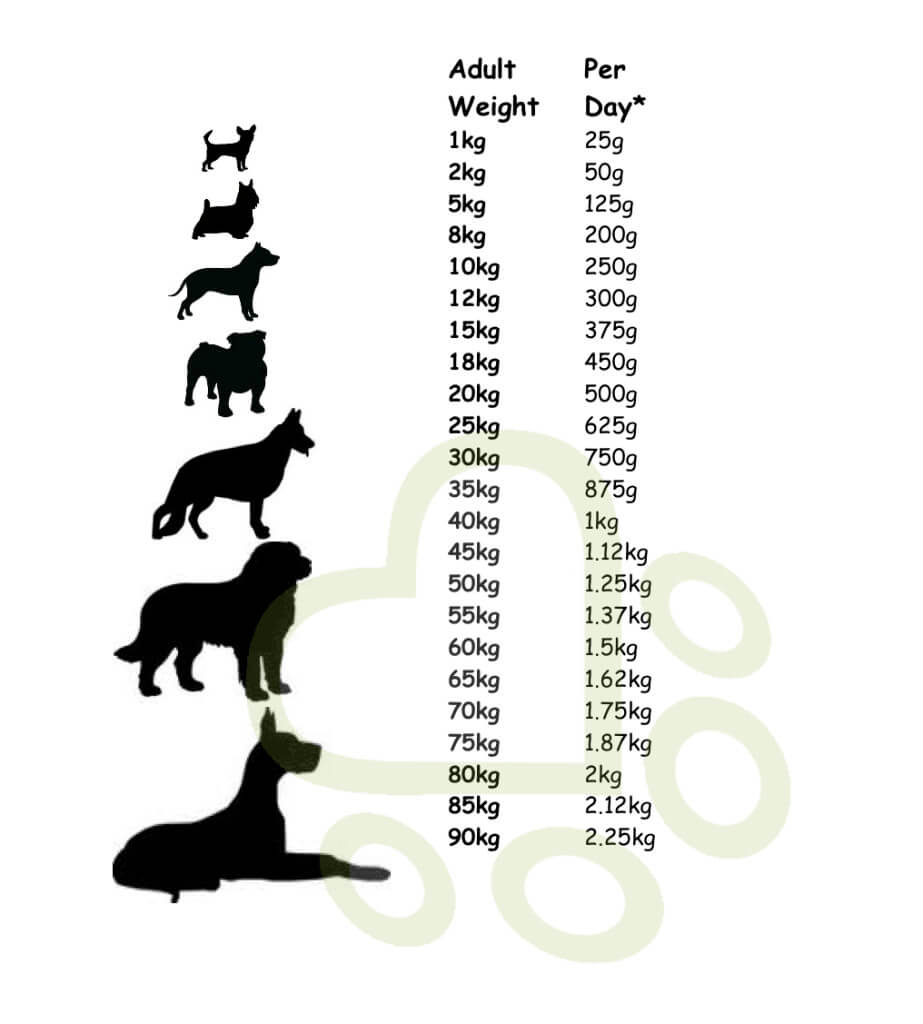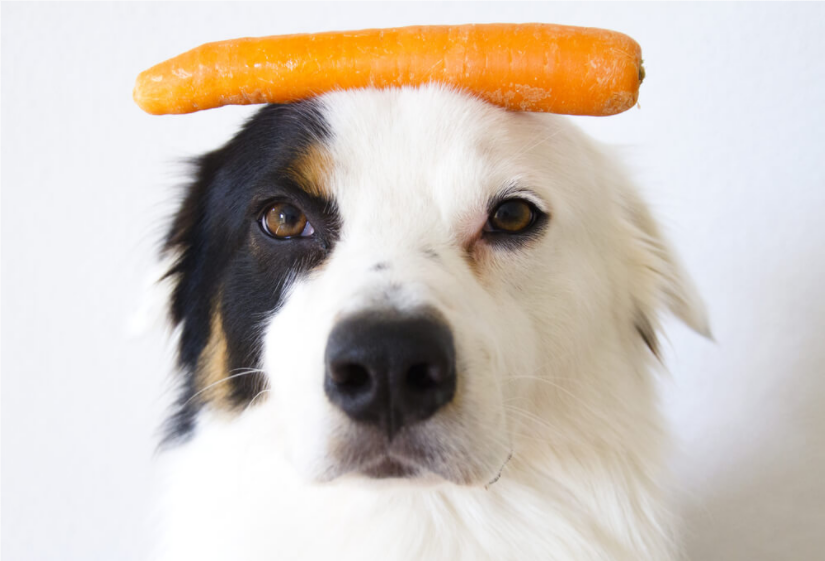Raw Diet for Dogs Feed Once a Day
Initially, moving to a raw diet for your dog can seem a little tricky. One of the most likely questions when shifting to raw dog food is how much should I feed my dog?
The answer can be simple (2.5% of his body weight per day, if an adult) but thereafter the figure varies depending on factors such as age, body weight, activity level, food types, and even the metabolism of your dogs.
Take into consideration any treats you may be feeding too as this will add to the calorific value (think of a cheeky biscuit you may have at coffee break).
This piece will help you work out the amount of raw food for your dogs (or you can skip the guff and just use our free online calculator!!).
- Recommended amount to feed
- Number of meals
- Factors that influence the total amount fed (age, bodyweight, activity level)
- Metabolisable energy – a more accurate method
- Free dog food calculator
How much should I feed my dog?
1. How much to feed an adult
The amount of food an adult dog needs is different from the amount puppies need. A healthy adult dog on an "average-calorie" fresh meat diet will need about 2% to 2.5% of their body weight per day, whereas an average puppy will consume much more.
For example, an 8 kg adult Westie would probably require around 200g of fresh dog food per day (1% of 8kg is 80g x 2.5 = 200g).

Start with the average percentage you work out and then increase or decrease the amount according to your own dog's needs. Factors that affect the amount fed include age, breed, activity level, weight goals (gaining or losing weight), raw food types (homemade or commercial raw foods), health issues, etc.
Remember, at all times, puppy to adult to senior, we want lean dogs. These are long distance running machines so think marathon runner (rather than 100m sprinter…). Every gram of body fat is inflammatory. They will live longer if kept lean. More on obesity in dogs here.
2. How much raw dog food to feed a pup
Puppies need more food than adult dogs for their rapidly growing bodies, plus they have growth spurts so important to remember.
If they go off their food, don't worry. If they are looking for more this may indicate a growth spurt – just like children.
The rule of thumb is that an 8-week old pup will consume up to 10% of its body weight per day.

By the time they reach 50% of their adult weight (around 6mths in a knee high dog, earlier for toys, much later for giants and up to 2 years), they will probably be consuming around 5% of their body weight daily. From there we aim to go down to around 3% of their body weight by the time they reach full body size (around 12mths for a knee high dog).
Pups can be moved on to ground, boneless raw dog food from weaning. They'll love it. As soon as those little teeth come out they'll very much appreciate a nice meaty bone to chew on, plus this encourages natural behaviour and may even stop them from chewing your furniture and shoes! By 4-5 weeks they will be eating normal raw dog food with bone ground in (depending on grind size) though some like to use higher fat mixes in young pups, such is their energy consumption. \
More on how to raw feed puppies here.
How many times to feed raw food to your dog per day
For adults, we have always recommended to split the total amount of raw food into two meals, morning and night. However, information moves on. We know that the less you use a gut the healthier the animal appears to be so in line with best fasting principles, we had started recommending these two meals get closer and closer together, giving the gut lots of time off (more on fasting here).
Now, it seems, dogs may be healthier on one meal a day. In fact, studies show dogs appear to live longer fed once per day. However, I would add that this study was of dogs fed commercial food, most of which I would view as dietary poison, so less of that high carb, insulin-spiking hell or none at all is surely better.
Still, a very interesting finding. I am now a one-meal-a-day man (at least my dog is…!).\

For puppies this advice changes. They eat so much it must be split between meals or they'll burst! For pups 4-12 weeks they should be fed around 4 times per day. From 12-24 weeks around 3 times per day and by half a year we drop it down to two meals until an adult.
Factors that influence the right amount of food
No dogs are alike, and numerous factors play vital roles in determining the adequate amount of food your dog may need per day. Age is one, as above. But also body size and activity level.

If your dog is chubby, feed him a bit less or choose leaner meat options. And if your dog is active, feed him a little more or move to higher fat mixes for a time.
Working dogs can eat 3-5% of their body weight per day, depending on what you have them doing.
| Adult Dog's Condition | Percentage of Foods Per Day (lb) |
|---|---|
| 1. Healthy and active | 2.5-3% of body weight |
| 2. Active & underweight | 3%+ of body weight |
| 3. Overweight and less active | 2-2.5% of body weight |
Be very careful about feeding your pregnant dog.
How active is my dog
- Little exercise (2%): Very little activity and mostly indoors. A dog should only have this low activity level if he is elderly, injured or unwell.
- Average (3%): 30-60 minutes of walking per day, including moderate playtime.
- High (4%): A 60-minute walk per day or more with energetic play.
- Working (5%): Farm dogs, sheep and cattle herding dogs, agility dogs, gundogs, Police dogs, etc.
More accurate measurements
These sorts of percentages are general guidelines that will get you an idea about how much raw food to feed your dog. However, while this is getting into the reeds a little, the exact measurements will depend on the type of food you are feeding.
A lean mix of meat offers fewer calories per kilo than a higher fat mix. For this reason, when assessing how much raw food a particular dog needs, it is better to measure on a ME (kcal/kg) basis. ME stands for Metabolisable Energy. (It's more detailed than most pet owners need, but I'm targeting other vets and veterinary students here.)
The formula for your dog's Resting Energy Requirement (RER) is:
RER=70 x (your dog's body weight in kg) ^ 0.75
You might need a scientific calculator to calculate your dog's RER.

Once you have worked out your dog's RER, you can use the following multipliers depending on your dog's physiological state. But know that two dogs of the same sex, from the same litter, with the same lifestyle, still CAN differ in their ME requirements by up to 20%.
- 1.6 Average for neutered adult
- 1.8 Average for intact adult
- 1.2 for Weight loss
- 2 for Light activities
- 3 for Moderate work
- 5-6 for Heavy work
- 3 for Growth (<4 months old)
- 2 for Growth (>4 months old)
Equipped with this measurement, you can check out your product of choice and see what kilocalories it offers per kg. That is how you'll be able to determine if the food is suitable for your dog or not. Most of the cheaper raw foods are much fattier than they state on the label. So be careful while buying raw dog foods.
Free dog food calculator
Suppose you don't want to bother with the complex calculations but want to provide the best for your beloved pet. In that case, we have a free dog food calculator on this site that will give you an idea about the proper amount and calories you will need per day, depending on your dogs' circumstances. Fill in the questionnaire correctly and it will provide you with the proper measurements of how much raw food to feed your dog.
Conclusion
By following this general guideline, if you regularly adjust the amount of the diet, your dog will always remain healthy. Just make sure to offer a selection of proteins – flavorful and delicious raw dog foods that are full of adequate vitamins and dietary nutrients that match your dog's energy level and digestive capabilities. And as for all things, consult with a vet before starting any new diets.
Source: https://dogsfirst.ie/how-much-should-i-feed-my-dog/